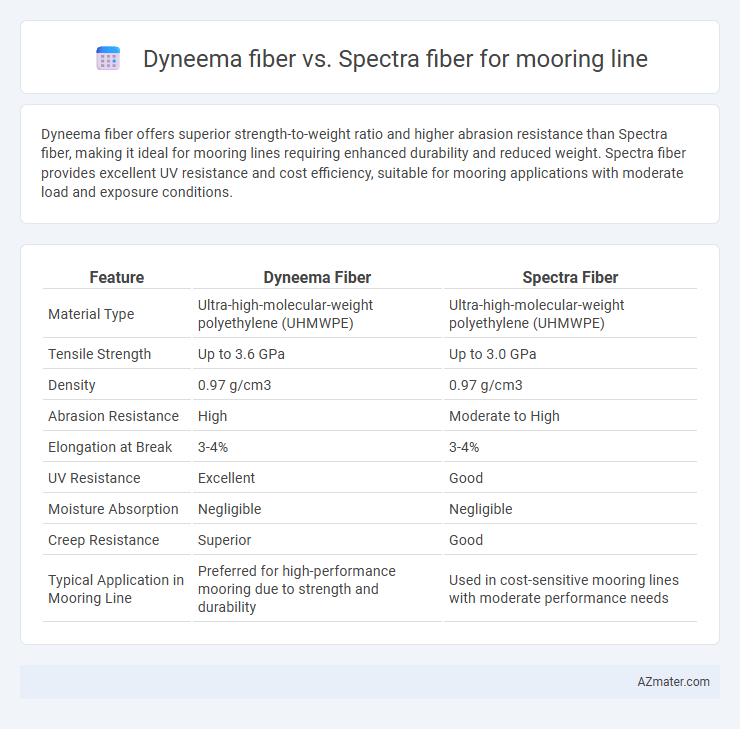Dyneema fiber offers superior strength-to-weight ratio and higher abrasion resistance than Spectra fiber, making it ideal for mooring lines requiring enhanced durability and reduced weight. Spectra fiber provides excellent UV resistance and cost efficiency, suitable for mooring applications with moderate load and exposure conditions.
Table of Comparison
| Feature | Dyneema Fiber | Spectra Fiber |
|---|---|---|
| Material Type | Ultra-high-molecular-weight polyethylene (UHMWPE) | Ultra-high-molecular-weight polyethylene (UHMWPE) |
| Tensile Strength | Up to 3.6 GPa | Up to 3.0 GPa |
| Density | 0.97 g/cm3 | 0.97 g/cm3 |
| Abrasion Resistance | High | Moderate to High |
| Elongation at Break | 3-4% | 3-4% |
| UV Resistance | Excellent | Good |
| Moisture Absorption | Negligible | Negligible |
| Creep Resistance | Superior | Good |
| Typical Application in Mooring Line | Preferred for high-performance mooring due to strength and durability | Used in cost-sensitive mooring lines with moderate performance needs |
Introduction to Dyneema and Spectra Fibers
Dyneema fiber, known for its ultra-high molecular weight polyethylene (UHMWPE) composition, offers exceptional strength-to-weight ratio and resistance to abrasion, making it a preferred choice for mooring lines in marine environments. Spectra fiber, similarly derived from UHMWPE technology, provides comparable lightweight durability and high tensile strength with excellent resistance to UV degradation and chemical exposure. Both fibers deliver superior performance over traditional materials, but Dyneema often leads with higher cut resistance and increased fatigue life, critical for heavy-duty mooring applications.
Fiber Composition: Dyneema vs. Spectra
Dyneema fiber is composed of ultra-high-molecular-weight polyethylene (UHMWPE) known for exceptional strength-to-weight ratio and high abrasion resistance, making it ideal for mooring lines subjected to dynamic loads. Spectra fiber, also made from UHMWPE, features a slightly different polymer processing technique that enhances flexibility and energy absorption, providing superior shock load performance in mooring applications. Both fibers offer low elongation and excellent UV resistance, but Dyneema typically exhibits higher tensile strength, while Spectra offers better handling and fatigue resistance.
Tensile Strength Comparison
Dyneema fiber exhibits a tensile strength of approximately 3.6 GPa, surpassing Spectra fiber, which typically offers tensile strength around 3.0 GPa. This higher tensile strength makes Dyneema preferable for mooring lines requiring enhanced load-bearing capacity and durability under dynamic marine conditions. Both fibers provide low elongation and excellent resistance to abrasion, but Dyneema's superior tensile strength directly translates to increased safety margins and longer service life in mooring applications.
Abrasion Resistance and Durability
Dyneema fiber offers superior abrasion resistance compared to Spectra fiber, making it highly effective in harsh mooring line applications where friction and wear are critical concerns. Its molecular structure provides enhanced durability, enabling longer service life under continuous mechanical stress and exposure to environmental elements. Spectra fiber, while strong and lightweight, tends to have lower abrasion resistance and may require more frequent inspection and replacement in abrasive conditions.
Weight and Buoyancy Differences
Dyneema fiber offers significantly lower weight compared to Spectra fiber, making it a preferred choice for mooring lines where reducing overall system weight is critical. Spectra fiber possesses slightly higher buoyancy than Dyneema due to its molecular structure, which can be advantageous in applications requiring positive flotation. The weight-to-buoyancy ratio of Dyneema results in more compact, easier-to-handle mooring lines, while Spectra's enhanced buoyancy aids in preventing line sinking in marine environments.
UV and Chemical Resistance
Dyneema fiber exhibits superior UV resistance compared to Spectra fiber, maintaining tensile strength and durability under prolonged sun exposure, which is crucial for mooring lines constantly exposed to harsh marine environments. Both fibers show excellent chemical resistance, but Dyneema displays enhanced resistance to hydrocarbons and alkalis, reducing degradation from oil spills and marine pollutants. These properties make Dyneema a preferred choice for mooring lines requiring extended service life and minimal maintenance in chemically aggressive and UV-intensive conditions.
Cost Analysis: Dyneema vs. Spectra
Dyneema fiber typically commands a higher price compared to Spectra fiber due to its superior tensile strength and enhanced durability, making it a preferred choice for high-performance mooring lines. Spectra fiber offers a more cost-effective solution with adequate strength and abrasion resistance, suitable for lighter or less demanding marine applications. When evaluating total cost of ownership, Dyneema's longer service life and reduced maintenance costs can offset its initial premium, whereas Spectra provides budget-friendly upfront costs with potentially higher replacement frequencies.
Performance in Mooring Applications
Dyneema fiber offers superior tensile strength-to-weight ratio and excellent resistance to abrasion and UV degradation, making it highly efficient for mooring lines subjected to harsh marine environments. Spectra fiber, while also strong and lightweight, typically exhibits slightly lower elongation and abrasion resistance, which can impact long-term durability under dynamic loads. For mooring applications demanding maximum load capacity and longevity, Dyneema consistently outperforms Spectra by providing enhanced performance with reduced maintenance requirements.
Longevity and Maintenance Requirements
Dyneema fiber offers superior longevity compared to Spectra fiber for mooring lines, due to its enhanced resistance to UV degradation and abrasion, which reduces the frequency of replacement. Dyneema's low moisture absorption and high chemical resistance minimize maintenance requirements, making it ideal for harsh marine environments. Spectra fiber, while strong and lightweight, tends to degrade faster under prolonged exposure to sunlight and saltwater, increasing upkeep efforts over time.
Choosing the Best Fiber for Mooring Lines
Dyneema fiber offers superior tensile strength and higher abrasion resistance compared to Spectra fiber, making it a top choice for mooring lines requiring enhanced durability and load-bearing capacity. Its lower elongation rate ensures minimal stretch under heavy loads, providing better control and stability during mooring operations. While Spectra fiber remains a reliable option with good fatigue resistance, Dyneema's advanced fiber technology delivers greater overall performance and longevity for critical mooring applications.

Infographic: Dyneema fiber vs Spectra fiber for Mooring line
 azmater.com
azmater.com